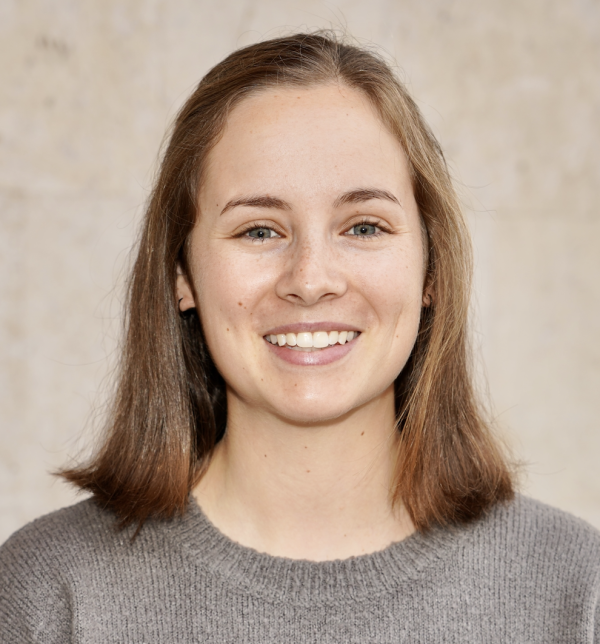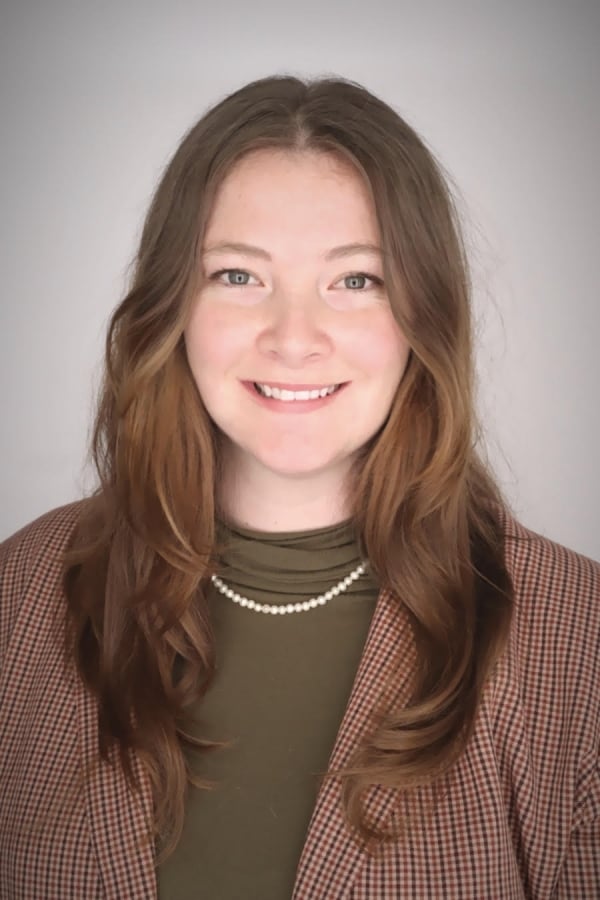Maura Slocum is passionate about soil.
A Peace Corps alum who worked with farmers during her service in Senegal, she can happily talk your ear off about how soil influences so many aspects of human life, from the water we drink and the food we eat to the land we live upon. “I just love that people think of it as dirt—one entity—but it’s a very important system,” she says.
Slocum was accepted to two Ivy League colleges to pursue her Ph.D. in soil science, but the choice between them wasn’t particularly difficult. The faculty member who would become her adviser was a perfect match, she recently recalled: “He worked with these soils in West Africa, and right off the bat, he was like, ‘I’m interested in the anthropology of these soils as well as the chemistry.’ And I was like, ‘Well, that’s exactly what I’d want to get a Ph.D. in.’”
But Slocum’s graduate school journey was quickly upended by the COVID-19 pandemic, which prevented her from doing research in Africa as planned. Later, toward the end of her program, she began experiencing debilitating burnout and was unable to submit chapters of her dissertation for publication. The mental toll academia had taken on her ultimately led Slocum to seek out nonacademic jobs.
The problem was where to look. Slocum had been somewhat interested in nonacademic jobs since she started her Ph.D., but she felt her program was geared toward producing faculty, which made the nonacademic job search intimidating and opaque. Worse yet, when she eventually found some opportunities and landed interviews, the hiring manager nearly always pressed her: Why wasn’t she becoming a professor?
She’s not alone. A massive—and growing—number of Ph.D. holders across all disciplines begin nonacademic careers after they graduate, but many who spoke to Inside Higher Ed said that their universities did little to prepare them to take that route. The institutions seemed to operate under the assumption that doctoral students would become professors, leaving them floundering, unsure where to look for positions or how to transform their lengthy curricula vitae into résumés.
But most doctoral students won’t become professors. The rate of graduates selecting nonfaculty jobs right out of their Ph.D. programs is substantial—and climbing. In 2003, 56.1 percent of science and engineering Ph.D.s and 36.3 percent of non-STEM Ph.D.s who secured jobs after graduation went into nonacademic roles. Today, according to the most recent data from the Survey of Earned Doctorates, an annual survey conducted by the National Center for Science and Engineering Statistics, those numbers have risen: Nearly three-quarters of science and engineering Ph.D.s now take jobs outside academia, along with 37.9 percent of those in non-STEM fields. (These numbers do not include those who go onto further study, including postdoctoral fellowships, nor do they include those who didn’t land a job after graduation.)
The reasons for seeking nonacademic jobs are varied, but they start with scarcity: The coveted full-time faculty role is becoming ever rarer, making up only 51 percent of all faculty positions in the U.S. in fall 2022 as compared to 67 percent in 1987. That’s made students less willing to risk it all on the chance they might snag such a role.
But many also say that at some point in their doctoral studies, they began to feel disillusioned with the idea of an academic career: because it promised a low salary, because it would almost certainly require them to move to another part of the country or because it all but guaranteed a difficult work-life balance, which they often saw firsthand in their mentors and advisers. Others said that they realized that the academic world simply wasn’t the right place to do the research they cared most about; projects in academia move too slowly, they said, or have too little reach to make what they saw as a significant impact.
Despite how prevalent it is, though, leaving academia isn’t always an easy choice. Like many, Maria Garay, who earned a Ph.D. in experimental psychology in spring 2024 at a selective private institution, spent the first several years of her program confidently on the path to becoming a professor. “I had a couple publications, I led workshops at national conferences, I gave talks at national conferences and I developed a very well-rounded and large community of other social psychologists around me,” she said.
She never had the misconception that becoming a professor would be particularly easy. But around her fourth year, she found herself becoming more and more aware of how little stability—and how little respect—the position can come with. She recalled participating in a hiring committee in which many of the candidates’ research focused on racism and discrimination, also Garay’s area of study. There, she said, she witnessed other committee members asking candidates rude, dismissive questions and wondered: Was that what she would have to face if she moved forward as a researcher of racism?

Maria Garay, a 2024 Ph.D. graduate, now works in consumer insights research.
Around the same time, she heard of a prolific psychologist who was denied tenure by her institution. It all left her feeling angry—betrayed, even—that she had never been warned about these parts of the profession.
“When you enter the program, there are people who tell you, ‘It’s hard; not everyone will become a professor.’ But then you also have people who tell you, ‘If you just work really hard, and you just get the publication, and you just prove yourself and you’re just the best at everything you do, it’ll work out,’” she said. “It felt like that was a lie.”
Falling Behind
Even as the number of doctoral students looking beyond academia rises, many programs still operate under the assumption that they’re training future professors. And with some exceptions—such as at elite universities with strong pipelines to the tech industry—few have significant infrastructure dedicated to helping doctoral students find and pursue nonacademic jobs.
Maybe it’s a leftover remnant of the long-ago days when higher education was a booming entity and earning a Ph.D. typically led to a full-time professorship. But with such jobs increasingly scarce, many students say they’re largely on their own when looking for alternatives—giving rise to online resource guides and a cottage industry of career coaches dedicated to helping Ph.D.s find jobs.
I didn’t feel confident that I knew what advice to give students, and I know for a fact that my students could have read that as a disapproval of career tracks outside of the academy.”
—Susan Carvalho, dean of the University of Alabama graduate school
The days of shaming students for wanting to leave academia have mostly abated, at least, though not entirely. Paula Krebs, the executive director of the Modern Language Association, told Inside Higher Ed in an interview that, just last year, she encountered a student from an elite college at a professional development workshop who told her he had lied to his adviser about why he needed the time off, afraid of backlash.
“Too often,” Krebs said, “faculty members see” pursuing nonacademic opportunities “to be a devaluing of what they’re doing.”
More often, though, current students and recent graduates say their professors were generally accepting of their decision to leave the academy, but struggled to assist students in reaching those decisions and figuring out where to go from there. In some cases, Ph.D.s said that it took them years to realize a nonacademic career was even on the table for doctorates.
That was the case for Benjamin Glasner, whose doctorate is in public policy and management and who now works for an economic policy think tank. When applying to both academic and nonacademic jobs after he concluded his postdoctoral fellowship, all he knew about the latter options he had learned from sporadic conversations with his peers, his network of friends in Washington, D.C., and random Google searches.
“Slowly and steadily, I started to get a picture of it,” he said. “But I, personally, didn’t have a great sense until I started doing that research almost on my own.”
Some professors are quick to admit that they have not always been the best supporters of their students entering nonacademic careers. Susan Carvalho, dean of the graduate school at the University of Alabama, said that although it wasn’t malicious, she knows that her lack of knowledge about such career paths may have negatively impacted her students in the past.
“I know it was true during the first half of my career as a Spanish literature professor. I didn’t feel confident that I knew what advice to give students, and I know for a fact that my students could have read that as a disapproval of career tracks outside of the academy,” she said. “If not a disapproval, at least an inability to help them.”
Some former students, like Slocum, say they had at least one faculty mentor who was supportive of their nonacademic aspirations, even if their department was less enthused. But this luck-of-the-draw system can be unfair to students who end up with less understanding mentors, said Krebs, who believes that graduate programs should be training their faculty members about, at a minimum, the basic nonacademic career paths common among their graduates.
I started kind of freaking out a little bit. I kept googling, ‘What can I do with my Ph.D.?’”
—Ashley Moses, doctoral candidate at Stanford University
“Faculty members can’t be expected to intuit this stuff,” she said. Departments need time and money to not only implement professional development initiatives for Ph.D.s, but also to get buy-in from faculty who may be reluctant to, say, let their students out of a few credit hours of Victorian literature to accommodate a mandatory professional development course. “Schools have to invest in this stuff.”
Filling the Void
People and organizations outside of academia have stepped in to fill the void. Ashley Moses, a current neuroscience doctoral candidate at Stanford University, has launched a research project called Ph.D. Paths, a public website that documents the career journeys of Ph.D. holders who left academia and aims to show current students the breadth of ways they can use their degrees.
The project was born of Moses’s own experience looking into career opportunities early in her graduate studies. “I started kind of freaking out a little bit, like, what do I do?” she said. “I kept googling, ‘What can I do with my Ph.D.?’ And I didn’t really feel satisfied with the answers that I was getting—if I can be a consultant, tell me how exactly I can be a consultant. I want to know the path you took to get there.”

Ashley Moses began her Ph.D. Paths project to illuminate the careers of Ph.D.s in nonacademic jobs.
Career coaching targeted at Ph.D.s seeking careers in industry has also become common, with numerous gurus, many of whom are ex-academics themselves, offering paid guidance for making the transition.
Ashley Ruba set up her coaching service after her own experience exiting academia three years into her postdoctoral fellowship left her wishing there had been more resources available to her. Now, she charges $250 an hour for a coaching session—though she is looking to adjust those rates, aware that many doctoral students and academics can’t afford her services.
“I think if they could access the support at their university for free, they would definitely do that,” she said.
Some institutions are beginning to adjust to the new normal—not just because they feel a responsibility to look out for their students’ best interests, but also because they don’t want students losing interest in their Ph.D. programs.
“Because of the reality of seeing their graduates not all get jobs, I think [faculty] realized quickly that they needed to help students find these paths if they were going to keep their doctoral programs,” said Carvalho of Alabama. “Departments would like to keep their doctoral degrees.”
That’s not just because of the research and teaching assistance Ph.D. seekers provide their institutions, though that’s certainly one reason. Carvalho said that it would be a big loss if only the most prestigious institutions—the ones that can more easily help their students build extensive networks with top companies—could continue offering Ph.D.s, particularly in the humanities, while programs at public universities died off.
“People like me in culture studies feel part of the richness of our professional dialogue is the perspectives that scholars keep bringing to the field,” she said. “And that comes from the diversity of institutional types and backgrounds and theoretical formations, and the loss of that is really threatening to humanities scholars—the potential loss.”
Alabama’s graduate school has made some strides to adapt to the need for nonacademic career guidance; the university offers career-oriented courses, and students have a choice between one tailored to future faculty and another tailored to those looking for work outside academia. In the latter class, Carvalho said, students learn how to find and identify good jobs for a Ph.D.—and then how to ensure they are qualified for them and can convey those qualifications when they apply. (This paragraph has been corrected to reflect that the courses are not required.)
It’s a challenge, because the nonacademic job market isn’t built for Ph.D.s; a minuscule number of jobs require them, and some employers and hiring managers even opt not to interview Ph.D.s because they see them as overqualified.
“We tell students to start thinking about how they would explain the competencies they’ve acquired within that framework of, what are employers looking for? Have they done anything involving a budget? Have they done anything involving deadlines? Have they done anything involving teams?” she said. “And we try to hook them up with campus opportunities to develop those competencies and have a record of those competencies for their CVs.”
A handful of highly selective universities have invested more heavily in these resources. Johns Hopkins University last year launched a new Doctoral Life Design Studio aimed at helping Ph.D.s envision and pursue the best path for them—regardless of whether or not that includes academia.
The university has long worked to help doctoral students access industry connections and internships, in 2020 dedicating almost a million dollars to Ph.D. professional development initiatives. The new office offers a one-on-one career consultation service—similar to what might be offered by a career coach like Ruba, or perhaps even a life coach—in which the consultant helps the student understand possible career pathways that fit their life goals and desires.
“We don’t make our decisions about our careers just based on our aptitude and strengths,” said Roshni Rao, Hopkins’s assistant vice provost for doctoral and postdoctoral life design. “There are several other things that we factor into consideration: Where we want to live, what is a meaningful career, what does it mean to have a fulfilling job, how do I become curious about multiple different paths that exist for me?”
Rao herself pivoted to professional development after her Ph.D., after a lifetime thinking she would become an academic.
“Four years into my postdoc, life came in the way. I got pregnant, I got married, I was an international scholar and so I had to make quick decisions about whether I wanted to continue doing biomedical research,” she said. “I made the pivot of my life, which was into the professional development space. And there are several hundred stories when we speak with alumni and employers and students themselves, that this is how it typically goes.”
‘Maybe I Do Regret It’
To some critics, the increasingly fruitless academic job market, combined with the growing number of Ph.D. holders who abandon academia of their own volition, is evidence that there simply are too many of them. Some see Ph.D.s programs as predatory for siphoning off some of the most important years of a person’s career for little pay—and little payoff.
In a 2021 blog post for Bloomberg, commentator Noah Smith argued that the U.S. is producing too many Ph.D.s, particularly in the humanities and social sciences, likening adjuncts waiting to get a full-time professorship to “waiters hanging around Hollywood hoping for their big break” and arguing that the growing frustration of underemployed doctorates in the private sector is a “recipe for societal dysfunction.”
For many who have gone through the transition from academia to industry, the reality is a bit more complicated.
Knowledge creation can benefit so many areas of the culture—not just higher education. You can train people in knowledge creation and then release them into the world to create knowledge.”
—Paula Krebs, executive director, Modern Language Association
Ryan Collins, who received a Ph.D. in media arts and science from a public flagship in the Midwest, said he felt that universities take on too many doctoral students to use as cheap labor, while knowing they probably won’t get a lot of value out of the degree. But when asked if he regrets his own Ph.D., he waffled. “In some ways, maybe I do regret it. In some ways I don’t.”
Collins is now an SEO strategist, a job that does not require a Ph.D. His colleagues don’t have advanced degrees, though he said his company seemed to see the value in his degree when hiring him. In an alternate universe, he said, he would have simply majored in marketing and gotten the same job he has now.
But the skills he learned in his program are useful. “With a Ph.D., you really learn how to ask really good questions. It really helps you be able to formulate a hypothesis. It makes you a better critical thinker. I think it extends in a lot of different areas,” he said.
To Krebs, the lack of tenure-track faculty positions isn’t a sign that there should be fewer Ph.D.s, but rather that everyone—employers, universities and students themselves—needs to recognize that the skills gleaned in a Ph.D. program are useful across a wide range of roles.
“We have to emphasize that the Ph.D. is about knowledge creation—it absolutely is about knowledge creation—and it’s training students to do that intellectual, deep-thinking work based in research and a solid command of the field,” she said. “But knowledge creation can benefit so many areas of the culture—not just higher education. You can train people in knowledge creation and then release them into the world to create knowledge.”

Maura Slocum said that even though her job doesn’t require a Ph.D., she doesn’t feel like the experience was a waste.
All of the Ph.D.s–turned–industry pros interviewed by Inside Higher Ed ultimately felt like their degrees were worth it for the skills they gleaned and the projects they were able to complete—though many had tossed the question around more than a few times prior to our conversation.
Slocum, the soil scientist, now works in conservation and sometimes feels that she should have pursued education in that field instead. At the same time, soil was her first love—she can still wax poetic about its importance, quipping, “People fight wars over good farmland”—and she thinks that her career may someday steer her back to the field that taught her to love research and applied science.
“I graduated with a friend in my department … and we do ask each other sometimes, ‘Did we just waste five, six years of our life?’ That word, ‘waste,’ we’ve really had to sit with,” she said. “The answer is always ‘no’ at the end of the day.”







